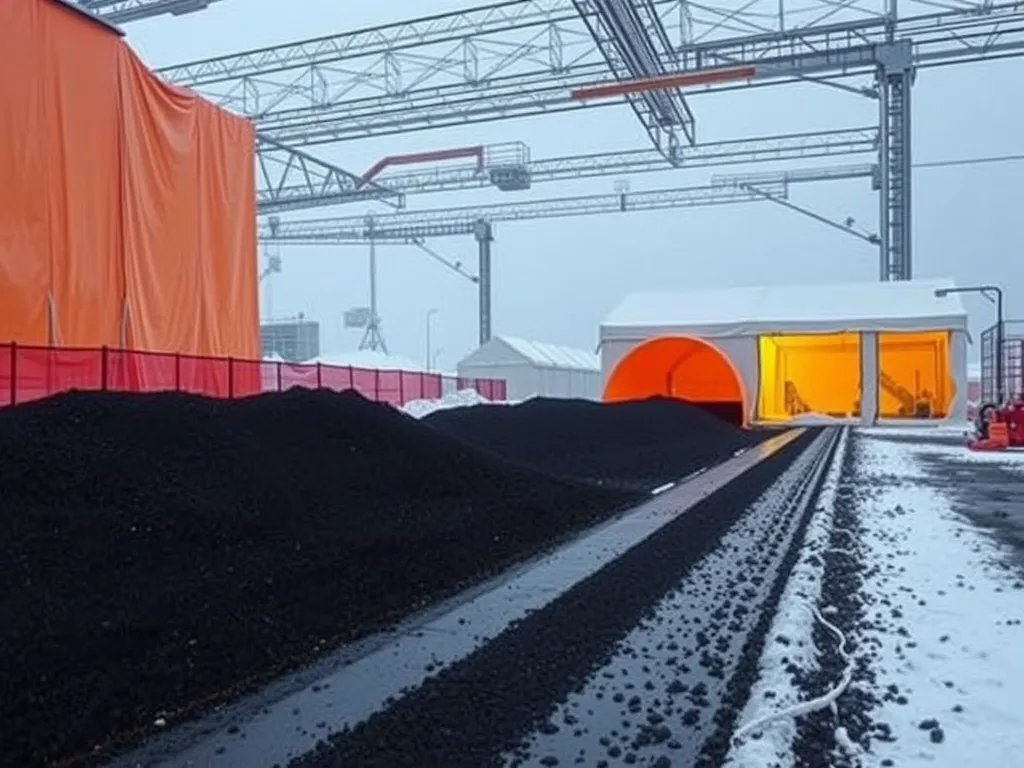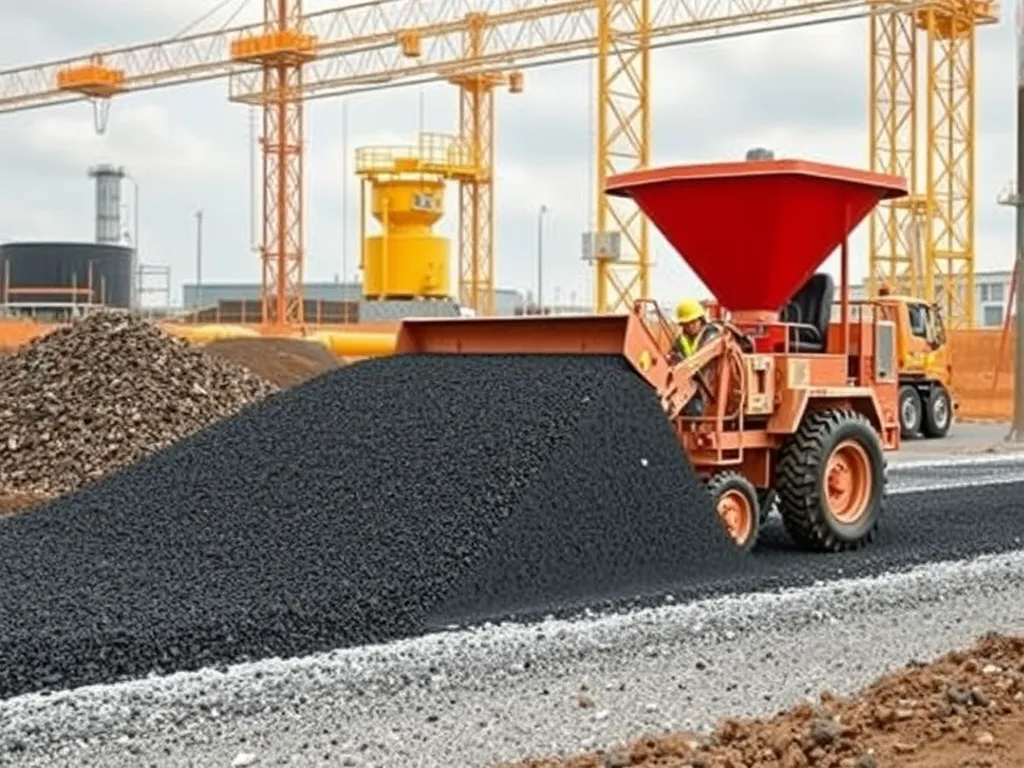Mastering Asphalt Cooling: Key Methods for Durable Roads
Published on: August 31, 2025 | Last Updated: April 14, 2025
Written By: George Voss
Best practices for asphalt cooling techniques ensure proper pavement curing while balancing temperature control and project timelines. These methods include water-based cooling, material additives like liquid ice, and operational strategies such as timed paving – all critical for achieving 95%+ compaction density. Proper cooling prevents premature cracking, maintains ideal viscosity for rolling (typically 220-290°F), and adapts to environmental factors like ambient temperature and wind speed.
This guide covers seven core aspects of asphalt temperature management. You’ll learn specific cooling methods from mist systems to chalk-water mixtures, optimal temperature ranges for application (275-325°F) and compaction, and advanced cool pavement technologies reducing surface heat by 30-50°F. We break down cost comparisons, environmental impacts, and real-world solutions for challenges like urban heat islands or tight project schedules.
Contents
Understanding Asphalt Cooling Fundamentals
Mastering temperature control separates adequate paving from exceptional results. Proper thermal management ensures stable pavement structures while preventing costly rework.
Why Proper Asphalt Cooling Matters
Asphalt loses 3-5°F per minute during standard cooling. Rapid temperature drops create uneven density, increasing risks of raveling and transverse cracking. Controlled cooling maintains workability for compaction while minimizing thermal contraction stress. Projects following asphalt cooling standards show 40% fewer surface defects within five years.
Ideal Temperature Ranges for Key Processes
Successful projects track three thermal benchmarks: placement, compaction, and curing. Deviations beyond 25°F from targets risk compromising pavement integrity.
Optimal Temperature to Apply and Cure Asphalt
Hot mix asphalt (HMA) requires 275-300°F at placement for proper aggregate coating. Maintain surface temps above 175°F during curing to prevent premature binder hardening. Warm mix asphalt (WMA) technologies allow 50°F lower application temps while meeting asphalt cooling methodology requirements.
Recommended Compaction Temperature for Asphalt
| Mix Type | Minimum Compaction Temp | Target Range |
|---|---|---|
| PG 64-22 | 220°F | 240-260°F |
| PG 70-28 | 250°F | 260-290°F |
Superpave specifications mandate completing compaction before mixes drop below grade-specific thresholds. Steel-wheel rollers achieve 92% density best between 225-275°F for standard HMA.
Monitoring thermal profiles helps crews adjust asphalt cooling techniques in real time. Next, we’ll examine how weather and material choices shape cooling strategies.
Factors Influencing Asphalt Cooling
Asphalt cooling rates shape project timelines and pavement quality. Multiple elements determine how quickly fresh asphalt reaches safe handling temperatures.
Environmental Conditions Impacting Cooling Rates
Ambient temperature, wind speed, and humidity create the cooling baseline. Asphalt loses 5°F every 10 minutes in 70°F weather with 10 mph winds. Direct sunlight adds 25-35°F to surface temperatures through solar radiation absorption. Rain delays cooling by trapping heat under steam layers.
| Factor | Impact Range |
|---|---|
| Air Temperature | 40°F: 0.5°F/min cooling | 90°F: 0.2°F/min cooling |
| Wind Speed | 5 mph: +15% cooling rate | 20 mph: +50% cooling rate |
| Relative Humidity | 30%: Standard cooling | 80%: 20% slower cooling |
Project-specific Variables in Temperature Management
Mix design and placement methods create unique cooling challenges. Polymer-modified PG 76-22 binders hold heat 30% longer than standard PG 64-22 mixes. Thicker 4-inch layers require 2.5 hours to reach 160°F compaction thresholds versus 45 minutes for 1.5-inch layers.
- Traffic Loading: High-traffic roads need 290°F laydown temps for density – adds 20% cooling time
- Base Material: Concrete subbases transfer heat 40% faster than asphalt bases
- Additives: Warm-mix asphalt technologies lower initial temps by 50°F but extend working windows
Night paving in urban heat islands requires infrared thermography to monitor thermal gradients exceeding 15°F across lanes. These variables demand customized asphalt cooling techniques for each job.
Mastering these factors sets the stage for deploying targeted cooling asphalt methods. Next, we explore practical solutions for temperature control during paving operations.

Effective Asphalt Cooling Methods
Successful asphalt projects rely on precise temperature control. These proven methods balance speed and quality while meeting asphalt cooling standards.
Water-based Cooling Techniques
Water remains the most accessible tool for managing pavement temperatures. Proper application prevents surface damage while accelerating the asphalt cool down process.
Mist Cooling Systems
High-pressure misters spray 5-10 gallons per minute across fresh pavement. This creates evaporative cooling without water pooling. Systems lower surface temps by 15-20°F when ambient humidity stays below 60%.
Strategic Water Application
Target water use on pavement edges first – areas most prone to rapid cooling. Avoid direct surface spraying during initial curing (first 30 minutes). Use oscillating nozzles at 45° angles for even coverage.
Advanced Material Solutions
New additives and mixtures enhance traditional asphalt cooling techniques. These solutions often cut cooling times by 25-40% compared to conventional methods.
Liquid Ice Additives
Dry ice pellets mixed into asphalt at the plant lower initial mix temps by 35-50°F. This extends the compaction window by 15-20 minutes. Costs average $8-$12 per ton but reduce roller passes by 30%.
Chalk-Water Mixtures
Slurry blends with 20% calcium carbonate reflect solar radiation. Field tests show 12-18°F surface temp reductions in peak sunlight. Requires specialized spray equipment ($15,000-$25,000 initial investment).
Operational Best Practices
Workflow adjustments significantly impact cooling rates without added costs. These asphalt cooling practices optimize existing resources.
Timing Paving for Optimal Cooling
Schedule pours when ambient temps drop below 85°F – typically before 10 AM or after 4 PM. Night paving reduces initial surface temps by 22-28°F compared to midday work.
Windrowing Techniques for Rapid Cooling
Spread mix in 2-3 inch windrows instead of full mat placement. This exposes 40% more surface area, cutting cooling time to 18-22 minutes versus 35+ minutes for standard methods.
Targeted Cooling of High-Temperature Batches
Use infrared thermometers to identify hotspots above 300°F. Apply focused cooling to these zones first – typically road centers and merge points. Reduces temperature differentials to under 15°F across the mat.
Proper cooling sets the stage for precise compaction. Next, we’ll examine temperature thresholds that ensure durable pavement density.
Also See: Asphalt Cost-effectiveness in Commercial Settings
Curing and Compaction Temp Rules
Hitting right temps for curing and compaction keeps roads strong. Wrong heat levels cause weak spots, cracks, or short life. Track thermal thresholds at each step to meet asphalt cooling standards.
Temp Thresholds for Good Compaction
Rollers must work fast once mix leaves the paver. Aim for 275°F to 300°F for most mixes. Below 225°F? Stop. Stone won’t lock tight. Gaps form. Use infrared guns to check mat heat every 15 mins. Warm-mix asphalt lets crews compact down to 175°F – a key asphalt cooling method for cold zones.
Curing Process Heat Needs
Asphalt starts curing at 185°F. Keep surface above 50°F for 24 hours. Binder needs slow cool-down to bond right. If temps drop under 40°F too fast, pavements get brittle. Night work? Use thermal blankets. Winter jobs may need heated tents. Track weather apps – sudden rain or wind changes asphalt cool-down rates.
Mastering heat control sets up success. Next, see how new tech takes pavement cooling further.

Cool Pavement Technologies
Modern asphalt cooling techniques extend beyond immediate temperature control. Innovations in pavement design now tackle heat reduction at the source through structural and material upgrades.
Types Of Temperature-reducing Pavements
Three pavement types dominate heat mitigation strategies. Each targets thermal absorption differently while maintaining load-bearing capacity.
Open-Graded Asphalt Mixes
Open-graded friction courses (OGFC) contain 15-25% air voids. These pockets allow heat dissipation and water drainage. Surface temps drop 5-12°F compared to dense-graded asphalt. Ideal for highways, they reduce splash/spray and lower road noise by 3-5 decibels.
Light-Reflective Coatings
Reflective sealants with titanium dioxide or glass beads boost solar reflectance. Applied at 0.1-0.3 gallons per square yard, they raise pavement albedo from 0.05 (standard asphalt) to 0.25-0.35. Reduces surface temps by 10-15°F in peak sunlight. Requires reapplication every 3-5 years.
Permeable Pavement Systems
Permeable asphalt layers (2-4 inch thickness) enable water infiltration at 100-500 inches/hour. Evaporation cools surfaces 7-20°F below conventional pavements. Installed at $3-$7 per square foot, these systems cut stormwater runoff by 75-95%.
Materials and Coatings for Heat Reduction
Specialized components enhance thermal performance without compromising durability:
- Phase-change materials (PCMs): Paraffin-based additives absorb heat at 90-110°F, reducing peak temps by 8-15°F
- High-albedo aggregates: Light-colored quartzite or limestone raises reflectance by 40-60%
- Graphene-enhanced binders: Improve thermal conductivity by 35%, accelerating nighttime cooling
These asphalt cooling methods intersect with environmental priorities. The next section examines how heat-reduction strategies impact urban ecosystems and long-term sustainability goals.
Environmental Considerations
Modern asphalt cooling practices extend beyond project efficiency. They address pressing ecological challenges faced by urban landscapes. From heat management to resource conservation, temperature control strategies now serve dual technical and environmental purposes.
Mitigating Urban Heat Island Effects
Traditional asphalt surfaces absorb up to 95% of solar radiation, elevating city temperatures by 2-5°F. Cool pavement technologies combat this through three mechanisms: reflective surfaces, enhanced evaporation, and thermal emittance. These methods align with EPA recommendations for sustainable infrastructure.
How Cool Pavements Reduce Ambient Temperatures
Open-graded mixes create air pockets that dissipate heat 40% faster than dense-graded asphalt. Light-reflective coatings boost surface albedo (solar reflectance) from 5% to 35%, cutting peak temperatures by 10-15°F. Permeable systems enable water storage and evaporation, providing natural cooling equivalent to 750BTU per square yard daily.
Balancing Performance and Sustainability
PG 76-22 polymer-modified binders maintain flexibility at lower temperatures while supporting recycled material use. Warm-mix asphalt technologies enable compaction at 275°F instead of 300°F, reducing energy use by 20%. The National Asphalt Pavement Association reports 97% recycling rates for reclaimed asphalt pavement (RAP) in cool mix designs.
Up next: While these methods offer environmental benefits, practical implementation faces cost and durability challenges. Let’s examine key limitations in real-world applications.

Limitations and Challenges
While advanced asphalt cooling techniques improve pavement performance, they bring unique hurdles. Let’s examine key trade-offs in cost, durability, and upkeep.
Cost Considerations in Cooling Methods
High-efficiency cooling strategies often require significant upfront investments. Mist cooling systems cost $15,000-$40,000 per mile for installation, while light-reflective coatings add $0.50-$2.50 per square foot. Liquid ice additives spike material costs by 18-22% versus standard asphalt mixes. Budget-conscious projects might prioritize windrowing or timed paving – methods with lower equipment expenses but higher labor demands.
Durability Concerns With Specialized Coatings
Temperature-reducing pavements face accelerated wear in harsh climates. Titanium dioxide-based reflective layers degrade 30% faster in freeze-thaw zones. Open-graded mixes, though effective at heat dissipation, lose 40% of void spaces within 5-7 years due to debris accumulation. Glass bead-enhanced surfaces maintain 85% reflectivity for just 3-5 years before requiring renewal.
Maintenance Requirements for Cool Pavements
Specialized cooling treatments demand rigorous upkeep schedules:
- Pressure washing permeable asphalt every 6-8 weeks ($120-$200 per 1,000 sq ft)
- Reapplying solar-reflective coatings every 36 months
- Clearing windrowed material within 2 hours of placement
Urban areas using chalk-water mixtures report 25% higher annual maintenance costs compared to traditional asphalt surfaces.
These practical realities shape decisions about cooling asphalt techniques. Next, we’ll address common questions about temperature thresholds and material performance.
Frequently Asked Questions
How Do You Determine the Cooling Rate Of Asphalt?
The cooling rate of asphalt can be influenced by several factors including ambient temperature, wind speed, and humidity. Utilizing infrared thermometers allows for real-time temperature monitoring, enabling adjustments to be made throughout the paving process to maintain optimal cooling rates.
What Are the Drawbacks Of Using Water-based Cooling Techniques?
While effective, water-based cooling techniques can lead to issues such as surface damage if not applied correctly. Over-watering can also cause weakening of the asphalt if done too early in the curing process, leading to improper bonding and increased susceptibility to cracks.
How Do Cool Pavements Contribute to Energy Efficiency?
Cool pavements reflect more solar radiation, thus reducing surface and ambient temperatures, which can lessen the need for air conditioning in nearby buildings. This leads to lower energy consumption and associated costs, making them an eco-friendly choice for urban development.
What Type Of Projects Benefit Most From Advanced Cooling Methods?
Projects in urban heat islands, high-traffic roadways, or areas with stringent regulations on temperature management benefit significantly from advanced cooling methods. These techniques ensure longevity and resilience in pavements that experience heavy use and elevated temperatures.
Are There Any Regulatory Considerations When Implementing Cool Pavement Technologies?
Yes, various local and national regulations may govern the use of innovative cooling technologies, particularly regarding their environmental impact. It’s essential to consult local building codes and sustainability guidelines to ensure compliance during project planning and execution.
What is the Recommended Maintenance for Cool Pavement Systems?
Maintaining cool pavement systems typically involves regular inspections and cleaning to prevent debris accumulation, reapplying solar-reflective coatings, and ensuring permeable systems remain clear to facilitate water drainage and cooling. Regular maintenance routines help maximize the performance and longevity of these specialized surfaces.
Closing Thoughts
Implementing the best practices for asphalt cooling techniques is vital for enhancing durability and performance. Proper temperature management not only ensures optimal compaction and curing but also addresses environmental issues such as urban heat islands.
From using water-based cooling methods to integrating advanced materials like liquid ice additives, there are numerous strategies available. Each approach offers unique benefits and should be tailored to specific project conditions. By prioritizing effective cooling methods, you can extend the lifespan of asphalt surfaces and enhance their resilience against heat.
Don’t forget to check out Asphalt Calculator USA for more insights on asphalt cooling practices and other essential construction resources.


